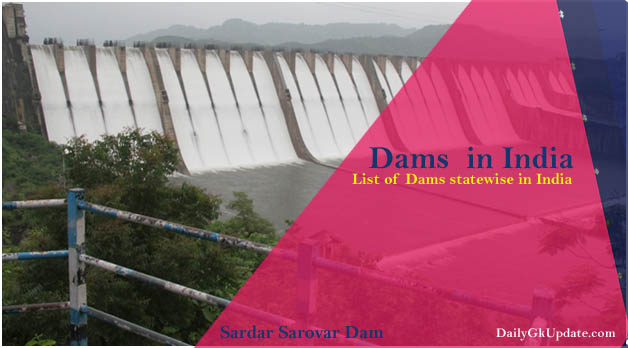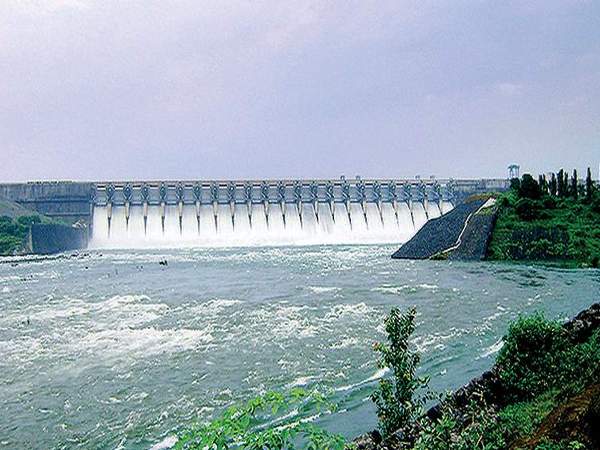Dams are the structures which are created to hold back the flowing water of rivers. And store the water for future uses. Which would have been wasted in the raining season and this water is used during the summer season when there is no rain. It plays an important role in water conservation. Dams have various uses and are important for humans as well as for nature.

Uses of Dams
- Stored water in the dam can be used for domestic, industry and irrigation purposes.
- Hydroelectric power production is one of the most important uses of the dam. Which helps in the generation of renewable energy.
- They help in flood control.
- It attracts tourists for boating and fishing which can be an income source for the government and local residents.
Type of Dams in India
- Rock-Filled Dams: Rock-fill dams are embankments of compacted free-draining granular earth with an impervious zone. The earth utilized often contains a high percentage of large particles, hence the term “rock-fill”. Example : Tehri Dam
- Concrete Gravity Dam is also known as “Gravity Arch Dam,” and is a freshwater-retaining concrete structure that has a wider footing (base) than the top-section. The purpose of a Concrete Gravity Dam is to maintain a low center of gravity, in order to avoid collapsing in the event of an abutment seal failure. Example Bhakra Nangal Dam
- Composite Dam : Composite dams are a combination of concrete and embankment dams. Construction materials of composite dams are the same used for concrete and embankment dams. Example : Hirakud Dam
- Masonry dams are dams made out of masonry – mainly stone and brick, sometimes joined with mortar. They are either the gravity or the arch-gravity type. Example: Nagarjuna Sagar Dam
- Gravity Dam: Dams constructed from concrete or stone masonry are Gravity dams. They are designed to hold back water by using only the weight of the material and its resistance against the foundation to oppose the horizontal pressure of water pushing against it. These are designed in such a way that each section of the dam is stable and independent of other sections. Example : Sardar Sarovar Dam
Important Dams of India
Ukai Dam

The Ukai Dam, constructed across the Tapi River, is the second largest reservoir in Gujarat after the Sardar Sarovar. It is also known as Vallabh Sagar. Constructed in 1972, the dam is meant for irrigation, power generation and flood control.
Type of Dam : Earth-cum-masonry dam
Tehri Dam
The Tehri Dam is located in the state of Uttarakhand. It is built on the Bhagirathi river. This is considered as the highest Dam in India with a height of 260.5 metres.
Type of Dam- Rock fill
Krishna Raja Sagara
Krishna Raja Sagara, is a lake and the dam that is located in the Mandya District of Karnataka.The gravity dam made of surki mortar is below the confluence of river Kaveri with its tributaries Hemavati and Lakshmana Tirtha. It is the main source of water for Mysore and Mandya. The water released from this dam flows into the state of Tamil Nadu and is stored in Mettur dam in the Salem district.
Type of Dam: Gravity Dam
Bhakra Nangal Dam
The Bhakra Nangal Dam is located in the state of Himachal Pradesh and Punjab. It is the largest dam in India having a height of 225 metres and also in the second position in the largest dams in all over Asia. It is situated on the river Sutlej.
- Type of Dam- Concrete Gravity
Hirakud Dam
The Hirakud Dam is located in the state of Orissa. It is the longest dam in India with a total length of 25.79 km. It is also in the list of the longest dams in the world. The Hirakud Dam is situated on the river Mahanadi.
- Type of Dam- Composite Dam
Nagarjuna Sagar Dam
The Nagarjuna Sagar Dam is located in the state of Telangana. It is India’s largest Masonry Dams built till date. It is the largest manmade lake in the world. It has 26 gates and is 1.55 km in length. It is situated on the river Krishna.
- Type of Dam- Masonry Dam
Sardar Sarovar Dam
The Sardar Sarovar Dam is located in the state of Gujarat. It is the largest dam in the Narmada Valley Project. This Dam is to benefit the other neighbouring states of Madhya Pradesh, Rajasthan and Maharashtra. It is situated on the Narmada River.
- Type of Dam- Gravity Dam
List of dams in India with river and state
To Know about the Dam’s location and the river they are built in is important for the aspirant preparing for the competitive exams. The name of the dam or its location is usually asked in this type of exam. In the high level examinations like UPSC, CDS or the State PSC more details are asked. Here is the complete list of all the important dams of India along with Pdf.
| Dam | River | State |
|---|---|---|
| Dibang Dam | Dibang River | Arunachal Pradesh |
| Ranganadi Dam | Ranganadi River | Arunachal Pradesh |
| Srisailam Dam | Krishna River | Andhra Pradesh |
| Subansiri dam | Subansiri River | Assam |
| Ukai Dam | Tapti River | Gujarat |
| Kadana dam | Mahi River | Gujarat |
| Dantiwada Dam | Banas River | Gujarat |
| Bhakra Nangal Dam | Sutlej River | Himachal Pradesh and Punjab Border |
| Chamera Dam | Ravi River | Himachal Pradesh |
| Baglihar Dam | Chenab River | Jammu and Kashmir |
| Uri Hydroelectric Dam | Jhelum River | Jammu and Kashmir |
| Maithon Dam | Barakar River | Jharkhand |
| Chandil Dam | Swarnarekha River | Jharkhand |
| Panchet Dam | Damodar River | Jharkhand |
| Tungabhadra Dam | Tungabhadra River | Karnataka |
| Linganamakki dam | Sharavathi River | Karnataka |
| Alamatti Dam | Krishna River | Karnataka |
| Krishna Raja Sagara Dam | Kaveri River | Karnataka |
| Narayanpur Dam | Krishna River | Karnataka |
| Malampuzha Dam | Malampuzha River | Kerala |
| Peechi Dam | Manali River | Kerala |
| Parambikulam Dam | Parambikulam River | Kerala |
| Idukki Dam | Periyar River | Kerala |
| Walayar Dam | Walayar River | Kerala |
| Mullaperiyar Dam | Periyar River | Kerala |
| Rajghat Dam | Betwa River | Uttar Pradesh and Madhya Pradesh Border |
| Barna Dam | Barna River | Madhya Pradesh |
| Bansagar Dam | Sone River | Madhya Pradesh |
| Gandhi Sagar Dam | Chambal River | Madhya Pradesh |
| Yeldari Dam | Purna river | Maharashtra |
| Mulshi Dam | Mula River | Maharashtra |
| Koyna Dam | Koyna River | Maharashtra |
| Jayakwadi Dam | Godavari River | Maharashtra |
| Panshet Dam | Ambi River | Maharashtra |
| Mula Dam | Mula River | Maharashtra |
| Kolkewadi Dam | Vashishti River | Maharashtra |
| Girna Dam | Girna river | Maharashtra |
| Vaitarna Dam | Vaitarna river | Maharashtra |
| Umiam Dam | Umiam River | Meghalaya |
| Khuga dam | Khuga river | Manipur |
| Tuirial Dam | Tuirial River | Mizoram |
| Rangit Dam | Rangit River | Sikkim |
| Radhanagari Dam | Bhogawati River | Telangana |
| Manair Dam | Manair River | Telangana |
| Nizam Sagar Dam | Manjira River | Telangana |
| Singur dam | Manjira River | Telangana |
| Gumti Dam | Gumti River | Tripura |
| Jalaput Dam | Machkund River | Andhra Pradesh and Odisha Border |
| Indravati Dam | Indravati River | Odisha |
| Hirakud Dam | Mahanadi River | Odisha |
| Vaigai Dam | Vaigai River | Tamil Nadu |
| Mettur Dam | Kaveri River | Tamil Nadu |
| Govind Ballabh Pant Sagar Dam | Rihand River | Uttar Pradesh |
| Tehri Dam | Bhagirathi River | Uttarakhand |
| Dhauli Ganga Dam | Dhauli Ganga River | Uttarakhand |
[WPSM_AC id=2051]
